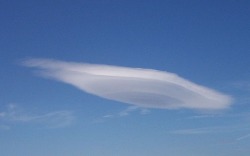UFO

Unidentified flying object (commonly abbreviated as UFO or U.F.O.) is the popular term for any apparent aerial phenomenon whose cause cannot be easily or immediately identified by the observer. The United States Air Force, which coined the term in 1952, initially defined UFOs as those objects that remain unidentified after scrutiny by expert investigators,[1] though today the term UFO is colloquially used to refer to any unidentifiable sighting regardless of whether it has been investigated. UFO reports increased precipitously after the first widely publicized U.S. sighting, reported by private pilot Kenneth Arnold in June 24 1947, that gave rise to the popular terms "flying saucer" and "flying disc." The term UFO is popularly taken as a synonym for alien spacecraft and generally most discussions of UFOs revolve around this presumption.[2] UFO enthusiasts and devotees have created organizations, religious cults have adopted extraterrestrial themes, and in general the UFO concept has evolved into a prominent mythos in modern culture.[3] Some investigators now prefer to use the broader term unidentified aerial phenomenon (or UAP), to avoid the confusion and speculative associations that have become attached to UFO.[4] Another widely known acronym for UFO in Spanish, French, Portuguese and Italian is OVNI (Objeto Volador No Identificado, with variant regional spellings).
Studies have established that the majority of UFOs are observations of some real but conventional object—most commonly aircraft, balloons, or astronomical objects such as meteors or bright planets—that have been misidentified by the observer as anomalies, while a small percentage of reported UFOs are hoaxes.[5] Only between 5% to 20% of anomalous sightings can be classified as unidentified in the strictest sense (see below for some studies).
The possibility that all UFO sightings are misidentifications of known natural phenomena[6] inspired some debate in the scientific community about whether scientific investigation was warranted given the paucity of available empirical data.[7][8][9][10][11] Very little peer-reviewed literature has been published in which scientists have proposed, studied or supported non-prosaic explanations for UFOs.[12] Nevertheless, UFOs as a cultural phenomenon continues to be the subject of serious academic research[12] and amateur investigators continue to advocate that UFOs represent real and unexplained events, whether or not they are associated with alien encounters.
Studies have established that the majority of UFOs are observations of some real but conventional object—most commonly aircraft, balloons, or astronomical objects such as meteors or bright planets—that have been misidentified by the observer as anomalies, while a small percentage of reported UFOs are hoaxes.[5] Only between 5% to 20% of anomalous sightings can be classified as unidentified in the strictest sense (see below for some studies).
The possibility that all UFO sightings are misidentifications of known natural phenomena[6] inspired some debate in the scientific community about whether scientific investigation was warranted given the paucity of available empirical data.[7][8][9][10][11] Very little peer-reviewed literature has been published in which scientists have proposed, studied or supported non-prosaic explanations for UFOs.[12] Nevertheless, UFOs as a cultural phenomenon continues to be the subject of serious academic research[12] and amateur investigators continue to advocate that UFOs represent real and unexplained events, whether or not they are associated with alien encounters.
